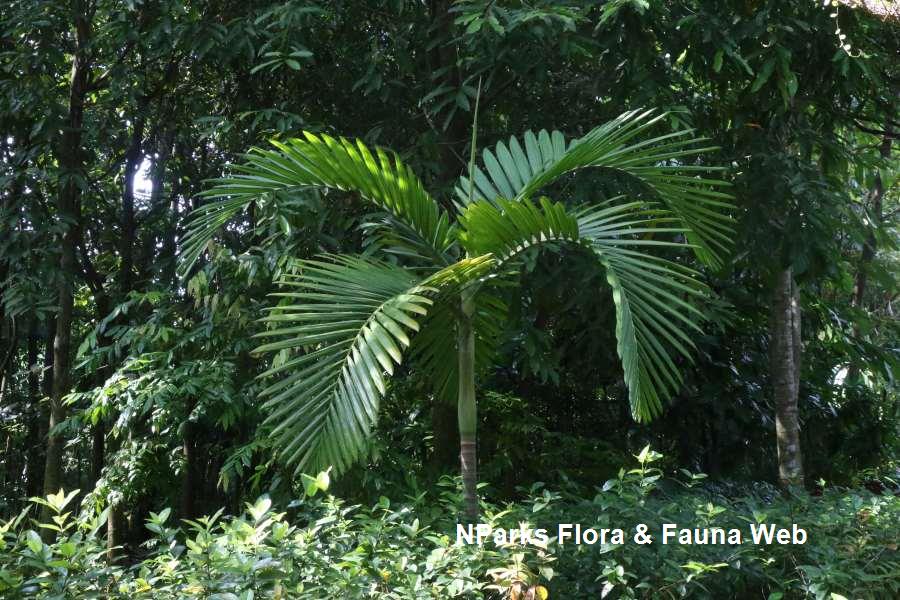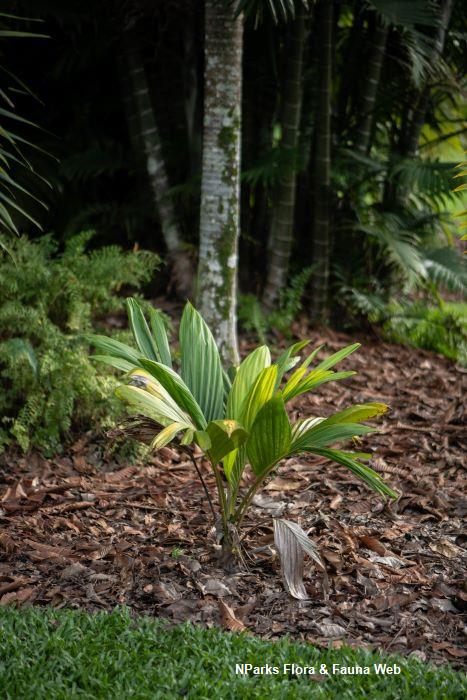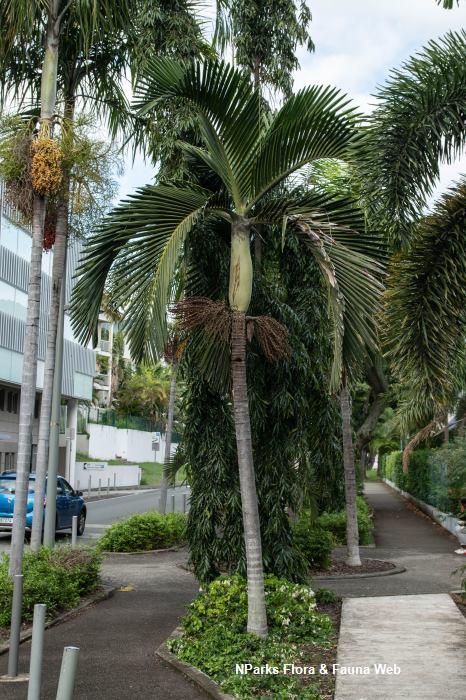
Back
Chambeyronia houailouensis Hodel & C.F.Barrett
| Family Name: | Arecaceae (Palmae) |
| Synonyms: | Chambeyronia macrocarpa ‘Houailou’, Chambeyronia 'Houailou' |
Chambeyronia houailouensis is a solitary-growing emergent palm endemic to New Caledonia, growing up to 10 - 25 m tall. Treated as a distinct species in 2021, this handsome palm is notable for its stiff, arching, pinnately-compound fronds and yellow-green crownshaft.
Name
Classifications and Characteristics
| Plant Division | Angiosperms (Flowering Seed Plants) (Monocotyledon) |
|---|---|
| Plant Growth Form | Palm (Solitary Habit) |
| Lifespan (in Singapore) | Perennial |
| Mode of Nutrition | Autotrophic |
| Plant Shape | Fountain (Palm-like) |
| Maximum Height | 10 m to 25 m |
Biogeography
| Native Distribution | New Caledonia |
|---|---|
| Native Habitat | Terrestrial (Primary Rainforest, Riverine) |
| Preferred Climate Zone | Tropical |
| Local Conservation Status | Non-native (Horticultural / Cultivated Only) |
Description and Ethnobotany
| Growth Form | It is a solitary, emergent palm, up to 10 - 25 m tall. |
|---|---|
| Trunk | The trunk is grayish-brown, up to 15 - 25 cm in diameter. It is slightly flared at the base and ringed with leaf scars. |
| Roots | Adventitious roots are present at the base of the trunk. |
| Foliage | The fronds are large (2.75 - 3.5 m long and 2.1 - 2.3 m wide), stiff, arching and even-pinnately compound with 35 - 45 leaflets on either side of the rachis. The petioles are short (8 - 20 cm long) and sideways D-shaped in cross-section. The leaflets are stiff, thick and leathery, arranged alternately to sub-opposite along the rachis. Whitish to brownish ramenta (thin, elongated scales on leaf surfaces) are present on the underside of the midrib and leaflet's main vein, which forms a ridge-like structure up to 40 cm long. The new fronds are green and rarely bronzy. Seedlings have bifid and undivided fronds. |
| Crown Shaft | The crown shaft is long (70 - 110 cm), yellow-green and tubular. It can be sparsely or densely covered in white, cottony, fine hairs. |
| Flowers | The inflorescence is an infrafoliar panicle, emerging below the fronds and crown shaft, and subtended by a persistent spathe or peduncular bract. It branches up to 3 orders between 40 - 50 rachillae (minor, secondary axes on inflorescences). The green to cream/off-white flowers are arranged in threes (1 female with 2 flanking males), in twos (both males), or singly (male) throughout the length of the rachillae. The male flowers have well-developed pistillodes (sterile pistils). |
| Fruit | The fruits are ovoid to long-ovoid drupes, up to 3.3 - 4.4 cm long and 2.7 - 2.9 cm wide, ripening to red. The single seed is 2.2 - 2.8 cm long and 2.3 - 2.5 cm wide. |
| Habitat | It grows in ravines and slopes of moist forest hills composed of ultrabasic soil and in flat alluvial areas, in lower elevations. |
| Similar | This species can be distinguished by the whitish to brownish ramenta on the underside of the midrib and leaflet's main vein, which forms a ridge-like structure up to 40 cm long. It can be confused with Chambeyronia macrocarpa and the closely related C. piersoniorum; apart from the ramenta, this species can be distinguished from the former by the well-developed pistillode in male flowers, and from the latter by its yellow-coloured crownshaft and larger fruits. |
| Taxonomy | This species was previously referred to in horticulture as Chambeyronia macrocarpa ‘Houailou’ or simply Chambeyronia ‘Houailou’ before being recognised as a distinct species in 2021. |
| Cultivation | It grows well in well-drained, loamy soil and bright, direct sunlight. It is easy to grow, highly adaptable and tolerates less fertile soil. Young plants can tolerate semi-shaded conditions, but mature plants grow better in full sun. It can be propagated by seed. |
| Etymology | The genus Chambeyronia is named in honour of Charles Marie Léon Chambeyron (1827 - 1891), a French naval officer and hydrographer, who mapped most of the coast of New Caledonia and assisted Vieillard in the exploration of the island. The specific epithet houailouensis refers to the village of Houailou where the species is cultivated that initially sparked interest in this species. |
Landscaping Features
| Desirable Plant Features | Ornamental Form |
|---|---|
| Landscape Uses | General, Parks & Gardens, Riverine, Suitable for Roadsides |
Plant Care and Propagation
| Light Preference | Full Sun, Semi-Shade |
|---|---|
| Water Preference | Moderate Water |
| Plant Growth Rate | Moderate |
| Rootzone Tolerance | Easy to Grow, Poor Infertile Soils, Well-Drained Soils |
| Propagation Method | Seed |
Foliar
| Foliage Retention | Evergreen |
|---|---|
| Mature Foliage Colour(s) | Green |
| Mature Foliage Texture(s) | Leathery, Thick |
| Prominent Young Flush Colour(s) | Green, Brown |
| Foliar Type | Compound (Even-Pinnate) |
| Foliar Arrangement Along Stem | Spiral |
| Foliar Attachment to Stem | Petiolate |
| Foliar Shape(s) | Palm Fronds (Pinnate / Feather) |
| Foliar Margin | Entire |
| Leaf Area Index (LAI) for Green Plot Ratio | 2.5 (Palm - Solitary) |
Non - Foliar and Storage
| Trunk Type (Palm) | Aboveground, Solitary Habit |
|---|---|
| Root Type | Aboveground (Prop / Stilt Root) |
Floral (Angiosperm)
| Flower & Plant Sexuality | Unisexual Flowers , Monoecious |
| Flower Colour(s) | Green, Cream / Off-White |
|---|
| Flower Grouping | Cluster / Inflorescence |
| Flower Location | Axillary |
| Inflorescence Type | Panicle |
| Ovary Position | Superior / Hypogynous |
| Flowering Habit | Polycarpic |
Fruit, Seed and Spore
| Mature Fruit Colour(s) | Red |
|---|---|
| Mature Fruit Texture(s) | Smooth |
| Fruit Classification | Simple Fruit |
| Fruit Type | |
| Mature Seed Texture(s) | Fibrous |
| Seed Quantity Per Fruit | Few (1-5) |
References
| References | Hodel, D.R., Baker, W.J., Bellot, D., Pérez-Calle, V., Cumberledge, A., & Barrett, C.F. (2021). Reassessment of the Archontophoenicinae of New Caledonia and description of a new species. Palms, Vol. 65(3); 109-131. |
|---|
Image Repository
Others
| Master ID | 34228 |
|---|---|
| Species ID | 8641 |
| Flora Disclaimer | The information in this website has been compiled from reliable sources, such as reference works on medicinal plants. It is not a substitute for medical advice or treatment and NParks does not purport to provide any medical advice. Readers should always consult his/her physician before using or consuming a plant for medicinal purposes. |




_lowres.jpg)